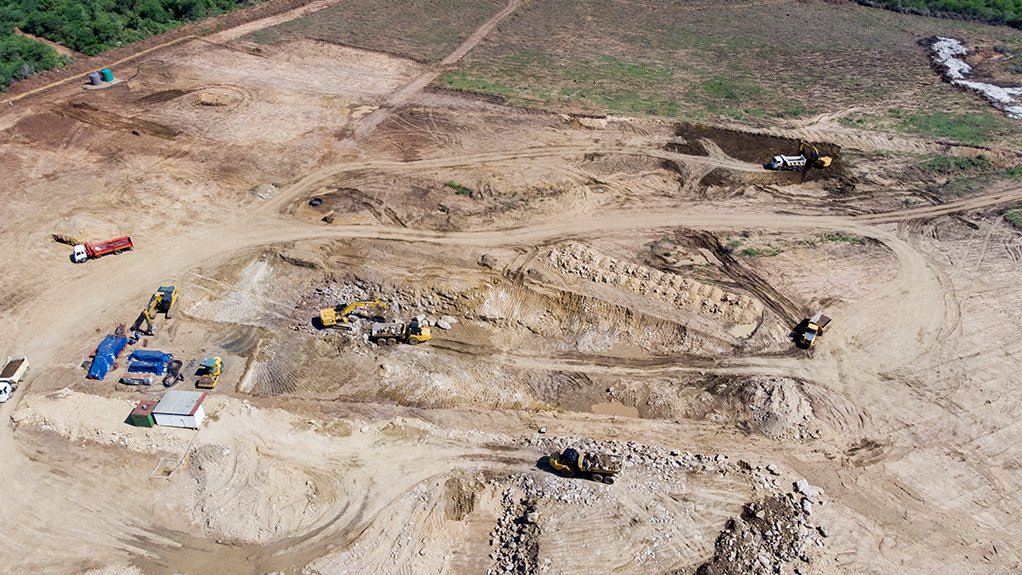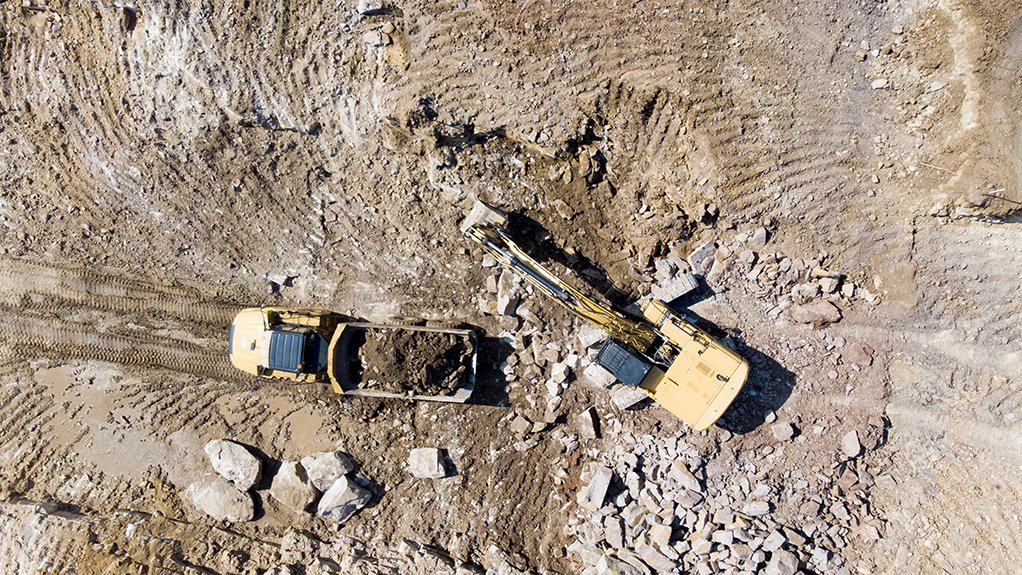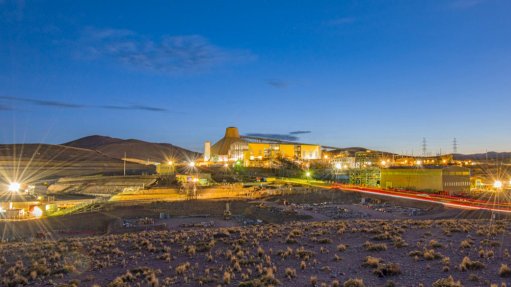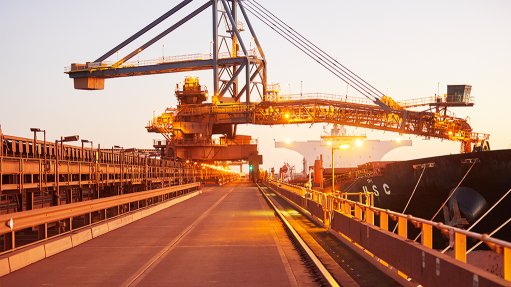Multimillion-rand shaft construction soldiers on



ON SCHEDULE The Mngeni shaft project is expected to achieve first coal in October this year, which is about 12 months after its start date
JOB CREATION ZAC employs 1 100 people in the area directly and indirectly, with Mngeni set to employ about 200 people once the shaft is fully operational
The R137-million Mngeni shaft project at the Zululand Anthracite Colliery (ZAC), in Emakhalathini, KwaZulu-Natal, is edging closer to completion, with water infrastructure and electrical reticulation installed last month.
This month, basic surface infrastructure, such as offices and change houses, will be finalised, ZAC GM Wayne Rowe tells Mining Weekly.
ZAC has spent almost half of its budget, with R67-million committed so far. To date, a significant portion of the Mngeni box cut has been mined and security arrangements have also been completed.
Acquired by private investment firm Menar in 2016, ZAC expects the Mngeni shaft project to achieve first coal in October this year, which is about 12 months after its start date.
The Mngeni shaft has an anticipated life of six years, with a resource of 1.2-million tons. Drill-and-blast mining methods will be used to boost ZAC’s production by an anticipated 180 000 t/y to 240 000 t/y of anthracite.
“We are not using conventional drill-and-blast methods to break rock here, but rather mechanical means, which has the benefit of not disturbing and inconveniencing the local community in the area,” highlights Rowe.
ZAC is developing and funding the Mngeni shaft, which will be about 240 m long and 34 m deep, with seam thicknesses from 2.3 m to 2.6 m.
“The design of the shaft had to consider the mine’s challenging geology, with which our team is very familiar. This in-house experience has ensured that no special measures were needed and the development has progressed according to schedule,” explains Rowe.
However, there has been scope creep regarding mining costs, as the decision was made not to mine the box cut in the traditional manner. The Mngeni shaft is about 7 km from ZAC’s processing plant, near the Masokaneni community.
Currently, the sole producer of prime anthracite in South Africa, ZAC employs 1 100 people in the area, either directly or as contractors servicing the operation, and the continuation of mining operations enables these people to remain employed, adds Rowe.
“Without new reserves, all these jobs would have been made redundant. Additionally, around 200 people will be employed once Mngeni is fully operational. Providing employment opportunities is part of ZAC’s commitment to create meaningful societal value in the communities in which it operates,” highlights Rowe.
ZAC is reviewing the feasibility of reopening its old Maye B shaft later this year. The final feasibility study is being completed.
Demand for Anthracite
Rowe says demand for anthracite is strong locally and globally, owing to anthracite’s being a high-premium coal with high carbon content that is suitable for various industrial applications, from steel to electrode paste manufacturing.
While 60% of the anthracite mined at Mngeni is destined for local use, 40% will be exported.
ZAC supplies anthracite to various European and Asian countries and the US.
The global anthracite mining market is growing, owing to rapidly developing countries, such as China and India, where population growth and consequent infrastructure development are increasing demand for domestic fuel and power generation projects.
“In addition, the ongoing Russia-Ukraine war has triggered Western sanctions against Russia, which is a major supplier of anthracite. Therefore, European anthracite importers have identified replacements elsewhere, including in South Africa,” elaborates Rowe.
About 89% of a blast furnace-basic oxygen furnace’s energy input comes from anthracite, 7% from electricity, 3% from natural gas and 1% from other gases and sources, according to the World Steel Association.
In the case of the electric arc furnaces, the energy input from anthracite accounts for 11%.
The global anthracite coal mining market size is set to expand significantly, partly in anticipation of a global coke shortage, according to a report, titled ‘Anthracite Coal Mining Market, 2022-2029’, by market research company Fortune Business Insights.
In addition, researchers from Australian financial services group Macquarie project a metallurgical coal deficit in the medium to long term, on the back of a likely demand increase from Asia.
The market size is expected to decline from $119.04-billion in 2022 to $117.98-billion this year at a compound annual growth rate (CAGR) of -0.9%, according to the ‘Anthracite Global Market Report 2023’, published by market intelligence specialist Business Research Company.
“The Russia-Ukraine war [. . . ] has led to economic sanctions on multiple countries, a surge in commodity prices and supply chain disruptions, causing inflation [ . . .] and affecting many markets across the globe,” explains the report, which predicts that the anthracite market size will decline to $113.24-billion in 2027 at a CAGR of -1.0%.
Comments
Press Office
Announcements
What's On
Subscribe to improve your user experience...
Option 1 (equivalent of R125 a month):
Receive a weekly copy of Creamer Media's Engineering News & Mining Weekly magazine
(print copy for those in South Africa and e-magazine for those outside of South Africa)
Receive daily email newsletters
Access to full search results
Access archive of magazine back copies
Access to Projects in Progress
Access to ONE Research Report of your choice in PDF format
Option 2 (equivalent of R375 a month):
All benefits from Option 1
PLUS
Access to Creamer Media's Research Channel Africa for ALL Research Reports, in PDF format, on various industrial and mining sectors
including Electricity; Water; Energy Transition; Hydrogen; Roads, Rail and Ports; Coal; Gold; Platinum; Battery Metals; etc.
Already a subscriber?
Forgotten your password?
Receive weekly copy of Creamer Media's Engineering News & Mining Weekly magazine (print copy for those in South Africa and e-magazine for those outside of South Africa)
➕
Recieve daily email newsletters
➕
Access to full search results
➕
Access archive of magazine back copies
➕
Access to Projects in Progress
➕
Access to ONE Research Report of your choice in PDF format
RESEARCH CHANNEL AFRICA
R4500 (equivalent of R375 a month)
SUBSCRIBEAll benefits from Option 1
➕
Access to Creamer Media's Research Channel Africa for ALL Research Reports on various industrial and mining sectors, in PDF format, including on:
Electricity
➕
Water
➕
Energy Transition
➕
Hydrogen
➕
Roads, Rail and Ports
➕
Coal
➕
Gold
➕
Platinum
➕
Battery Metals
➕
etc.
Receive all benefits from Option 1 or Option 2 delivered to numerous people at your company
➕
Multiple User names and Passwords for simultaneous log-ins
➕
Intranet integration access to all in your organisation




















